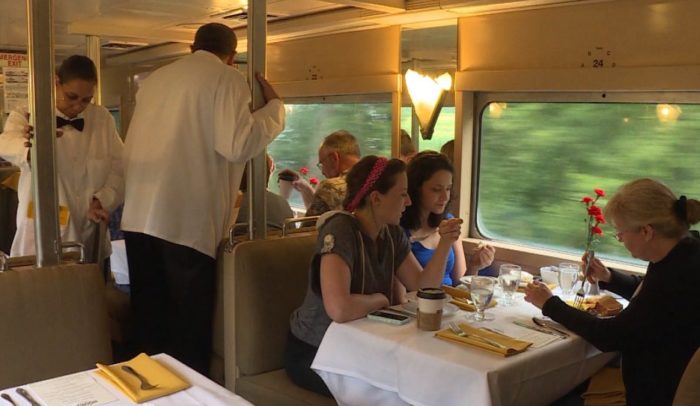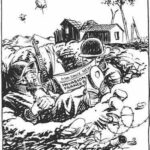The Hoosier State Experiment.
The Hoosier State is an all-coach train that runs four days a week between Chicago and Indianapolis. On the other three days, those cities are served by The Cardinal, which continues beyond Indianapolis to Charlottesville, Washington and New York City.
About a year and a half ago, with both the blessings and some subsidy from the State of Indiana, the Hoosier State was turned over to a private company, Iowa Pacific Holdings. Amtrak supplied the engineers and conductors, while Iowa Pacific provided the equipment—locomotives, coaches and a combination dome/dining/lounge car— and the staff to serve the passengers.

It was a popular service, and no wonder. Business class passengers rode in the dome and got complimentary food; regular coach passengers had comfortable seats and access to the dining car, which was, in fact the lower level of the dome car. Their food was for purchase but, from what I’ve been told, was quite good and actually cooked on board.
But it didn’t work. Amtrak took over the Hoosier State as of the first of this month, with ordinary Amtrak coaches and a cafe car selling the usual Amtrak “snack bar” offerings. I haven’t seen any public announcements, but I’d be inclined to bet the farm that it was because Iowa Pacific lost money. Probably a lot of money.
But why? All the reports I’ve seen said the service was very good. I would guess one reason is the schedule. The Hoosier State leaves Chicago at 5:45 p.m. and finally gets to Indianapolis just before midnight. That’s almost five hours to cover just under 200 miles. Map quest says you can drive it in less than three hours.
And if you’re going to take the Hoosier State in the other direction, from Indianapolis to Chicago, better set your alarm because that train leaves at 6:00 a.m.
There must be other reasons why this didn’t work out for Iowa Pacific. But their experience does serve to underscore how difficult it is for private enterprise to operate passenger trains at a profit. It takes a huge investment and the risks are formidable even for routes where there is a demonstrable demand for rail service. It is a classic example of how government can and should step in and make up the difference with—OK, now, are you ready for it?—with a subsidy.




Yes, the main problem that we all agree on is that, for Indy-Chicago commuting, the schedule is terrible, some of the track isn’t very good, and, as it is, the trip takes too long to attract a mass number of travelers. For the Hoosier State to be successful for anyone, as I see it, probably requires a dedicated seven-day-week schedule totally divorced from Amtrak’s Cardinal, and maybe a shorter route (that I think might have existed in the pre-Amtrak days).
By the way, probably then, and only then, would we have a definitive idea on whether subsidies were or were not required. Certainly as a passenger I would be glad to pay a premium for on-board food preparation and amenities such as dome cars. And it could
be possible that profit margin potential could be higher for a private operator if that operater wasn’t saddled with expensive Amtrak labor union contracts.
Just some thoughts. I do wish I had had an opportunity to ride Iowa Pacific’s Hoosier State.
What doomed the “Hoosier State,” no matter who funded it or how it was operated was an aggregate ‘bad things happening to a good train’ including:
1) Pathetically slow, uncompetitive schedule of 5.05 hours vs. 3+ hours by bus or auto. Not even the high parking rates in Chicago nor the conga lines of trucks along the potholed I-65 could move traffic to rail.
2) Ridiculous departure/arrival times in both IND and CHI. For whatever reason, no effort apparently made to move departure from IND to at least 7 or 730 am; move CHI departure to 345 or 430pm.
3) Total lack of frequencies to provide convenience for day-trippers or weekenders. One daily round trip does not cut it; nor, the higher prices charged on “Cardinal” days. Minimum frequency requirement would be 2; preferably, 3 daily trains (with the proposal of one continuing towards Cincinnati/Louisville).
4) Unreliability of schedule; particularly stabbed along 29 miles between Dyer, IN-CHI, operating thru, I believe, 5 different railroad dispatchers.
Major issue just to fund rehabilitation of deteriorated CSX roadbed and signal system between Dyer-IND. Also, in 2014, it was estimated to require $500,000 for 2 power switches at Dyer to re-route over the CN along lakefront to achieve Chicago Union Station via the St. Charles Air Line.
In reflection on these costs, how would the airlines manage without public funding of their airports and air traffic control system? How would Megabus and Greyhound compete without public funding of the interstate highways?
> It takes a huge investment and the risks are formidable
We see these attempts occasionally – I think the issue seems to be that nobody makes a “huge investment”. Even greatly improved this was still a slow and infrequent service.
Can these services succeed when a “huge investment” is actually made? The Brightline will be one potential answer to that question. They have made a “huge investment” – and will provide a competitive frequent service with modern consists. None of that describes the Hoosier, operated by Iowa Pacific or Amtrak.
Agreed. Considered to be the classic role of government in a mixed economic system, providing the factors of production, land, labor and capital to institutions deemed necessary but not profitable in the marketplace. As a goal in obtaining a balanced transportation system, government assistance is provided to most modes of public transportation.